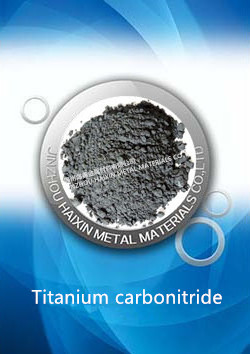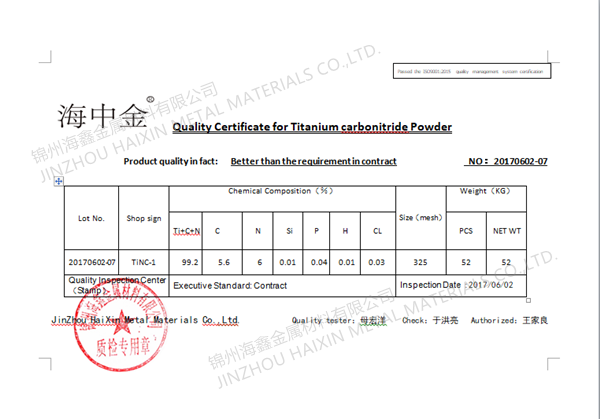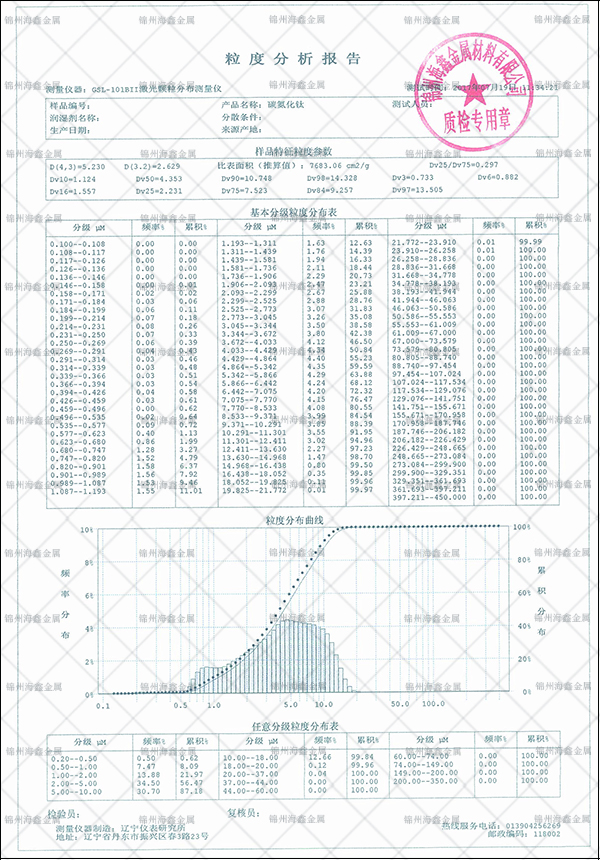Titanium Carbonitride(TiNC)



Chinese name: titanium carbonitride
English name: Titanium carbonitride
CAS: 12654-86-3
MDL: MFCD01868685
Molecular formula: TiCN
Molecular weight: 121.75
Melting point: 2900 ℃
Density: 5.08 g/mL at 25 ° C (lit.)
Hardness (HV): 34GPaI density is 4.52
Properties: gray or gray-black powder with hexagonal crystal structure, low internal stress, high toughness, good lubricity, high hardness, wear resistance and other characteristics, suitable for occasions requiring low friction coefficient and high hardness.
Technical performance:
1. The cermet made of titanium carbonitride has the following characteristics: the hardness (HRA) is as high as 91-95, which can reach the hardness level of non-metallic ceramic tools; It has good wear resistance and ideal resistance to crescent pit wear. The wear rate is very low when high-speed cutting steel, and its wear resistance is 3-4 times higher than that of WC-based cemented carbide; It has high heat resistance, high temperature hardness, high temperature strength and high temperature wear resistance. It can be cut at 1100-1300 ℃. Generally, the cutting speed is 2-3 times higher than that of WC-based cemented carbide; It has good chemical stability and high antioxidant capacity; Compared with cemented carbide, titanium carbonitride cermets have high wear resistance, lower oxidation degree, better thermal shock resistance, and are suitable for use as high-speed cutting tool materials, which can well control the geometric accuracy and tolerance of the workpiece, high finish, and high feed speed; Good results can be obtained when processing carbon steel, stainless steel, microalloyed steel and nodular cast iron.
2. Titanium carbonitride is a glossy black powder, which is a zero-dimensional ternary solid solution. TiC and TiN are the basis of titanium carbonitride, which have the NaCl type structure of face-centered cubic lattice, and can also form a solid solution with various transition metal carbides such as TaC and NbC. Titanium carbonitride is a compound compound formed in a single TiC lattice where nitrogen atoms (N) occupy the position of the original carbon atoms (C) in the lattice. There are two ideal modes for the proportion of carbon and nitrogen atoms in TiCxNy, namely, TiC0.5N0.5 and TiC0.3N0.7. Because TiCN has the comprehensive properties of TiC and TiN, and its hardness is higher than TiC and TiN, it is an ideal tool coating material. The coating can not only improve the bonding strength with the substrate, but also have the comprehensive properties of various materials.
Purpose: 1) Wear resistance, acid and alkali resistance, strong conductivity and thermal conductivity, small coefficient of thermal expansion, excellent chemical stability and heat resistance. It is widely used in cutting tools, powder metallurgy and cermet products.
2) Coating: TiCN has lower friction coefficient and higher hardness than TiN. The tool coated with titanium nitride carbide is more suitable for cutting hard materials such as stainless steel, titanium alloy and nickel alloy. It has more wear resistance and high temperature stability, and can significantly improve the tool life. Titanium nitride coating (TiN) is a general-purpose PVD coating with a thickness of 2300HV. It is a hard coating material with mature technology and widespread application. Features: high hardness, high wear resistance and oxidation resistance. Purpose: Suitable for most cutting tools and high-speed steel cutting tools or forming tools to improve their machining performance. It is also suitable for most forming dies and anti-wear parts. Titanium nitride carbide coating (TiCN), in which carbon element is added, can improve tool hardness and obtain better surface lubricity to reduce friction coefficient. It is an ideal coating for high-speed steel tools. The thickness of the coating is 2800HV, which prevents crack propagation and reduces edge collapse.
3) It combines the advantages of TiC and TiN. In addition to being very suitable for high-end precision machining and near-net forming processing, it has significantly improved the brittleness of TiC due to the introduction of N on the basis of maintaining the characteristics of TiC. With the increase of N content, its hardness decreases and its toughness increases. It is precisely because of its excellent comprehensive properties that titanium carbonitride based ceramics have been widely used in the fields of cutting, high-temperature resistant materials, measuring tools, petroleum and chemical industry, watch and clock appearance, etc.
4) Refractory materials, non-oxide added to refractory materials, will bring some excellent properties. Some studies have shown that the existence of titanium carbonitride can significantly improve the service performance of refractories.
Preparation method:
1. High temperature solid solution method
High-temperature solid solution method is a traditional method for preparing Ti (C, N) powder, which is usually formed by mixing a certain amount of TiN and TiC powder uniformly and hot pressing solid solution at 1700~1800 ℃, or by solid solution at higher temperature in Ar or N2 atmosphere. In order to inhibit grain growth and improve powder activity and sintering performance, the solution temperature can also be appropriately reduced. Even if the solution temperature is reduced, the high temperature solution method also has the disadvantages of high reaction temperature, high energy consumption, difficulty in obtaining high-purity powder, and difficulty in accurately controlling the N/C ratio.
2. High temperature nitridation of TiN and C powder
The high-temperature nitridation method usually takes TiN powder and C powder as raw materials, and then carries out long-term carbonitriding treatment under high temperature and N2 or Ar atmosphere after mixing, so as to obtain Ti (C, N) powder. Frederic et al. synthesized Ti (C, N) powder with nano-sized TiN powder+10wt% carbon black in Ar gas stream at 1430 ℃ for 3h, and showed regular shape submicron particles. Similarly, the high-temperature nitriding process has the disadvantages of high reaction temperature, low production efficiency, high energy consumption and high production cost.
3. High temperature self-propagating reaction method
High-temperature self-propagating reaction method is to mix Ti powder and C powder evenly, pre-press and form the compacts, and then "ignite" the reaction at high temperature in the device containing N2, so as to obtain bulk products. Ti (C, N) powder can be obtained by crushing and refining.
4. Self-propagating synthesis induced by high-energy ball milling
As a powder processing method, high-energy ball milling can not only uniformly mix and activate the powder to reduce the sintering reaction temperature and promote alloying, but also induce the self-propagating reaction to synthesize nano-Ti (C, N) powder at room temperature. The technology of Ti (C, N) synthesis induced by high-energy ball milling and self-propagation combines powder mixing and reaction, overcomes the traditional high temperature conditions, and can directly obtain Ti (C, N) powder.
5. TiO2 carbothermal reduction nitridation method
The carbothermal reduction nitridation process is a process of synthesizing Ti (C, N) powder by reduction of TiO2 and C powder in N2 at high temperature. The size and morphology of the products of the carbothermal reduction method can be controlled by process parameters, and is widely used in industrial large-scale production.
6. Ammonolysis
The ammonolysis process usually involves dissolving TiCl4 into appropriate solvent and adding additives at normal temperature, mixing them evenly and reacting with NH3 to produce a uniformly mixed intermediate of Ti amine compounds and additives, then mixing the intermediate with NH4Cl solution to precipitate and remove the amine in the intermediate, and then pyrolysis in vacuum or Ar atmosphere at 1200~1600 ℃ to obtain Ti (C, N) powder. The characteristic of ammonolysis is that the preparation temperature is lower than the traditional preparation method (high temperature solid solution method, 1800 ℃). The Ti (C, N) powder obtained has the advantages of high specific surface area, small particle size, concentrated particle size distribution and high purity, but the cost is high and the process is complex.
Storage conditions:
Precautions for storage: Store in a cool, dry and well-ventilated special warehouse with sealed packaging.





